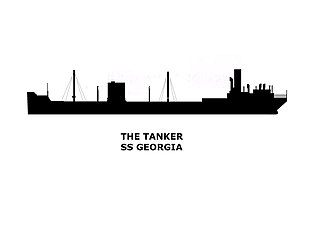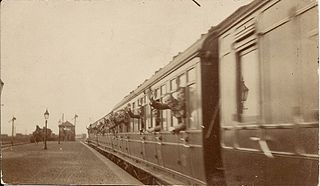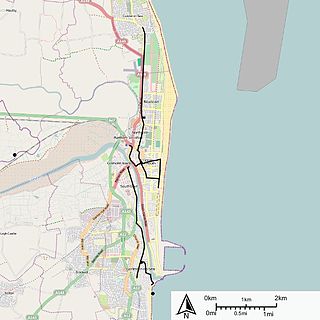Related Research Articles

Great Yarmouth, often called Yarmouth, is a seaside town which gives its name to the wider Borough of Great Yarmouth in Norfolk, England; it straddles the River Yare and is located 20 miles (32 km) east of Norwich. Its fishing industry, mainly for herring, shrank after the mid-20th century and has all but ended. North Sea oil from the 1960s supplied an oil-rig industry that services offshore natural gas rigs; more recently, offshore wind power and other renewable energy industries have ensued.

Gorleston-on-Sea, historically and colloquially known as Gorleston, is a seaside town in the borough of Great Yarmouth in Norfolk, England. It lies to the south of Great Yarmouth town centre, on the opposite side of the mouth of the River Yare. Historically in Suffolk, it was a port town at the time of the Domesday Book. It was incorporated into Great Yarmouth in 1836. Gorleston's port became a centre of fishing for herring along with salt pans used for the production of salt to preserve the fish. In Edwardian times the fishing industry rapidly declined and the town's role changed to that of a seaside resort.

The Borough of Great Yarmouth is a local government district with borough status in Norfolk, England. It is named after its main town, Great Yarmouth.

North Walsham railway station is on the Bittern Line in Norfolk, England, serving the town of North Walsham. It is 16 miles (26 km) down the line from Norwich, between Worstead to the south and Gunton to the north.
The Norfolk and Suffolk Joint Railway (NSJR) was a British joint railway company.

Gorleston Football Club is a football club based in Gorleston, Norfolk, England. They are currently members of the Isthmian League North Division and play at the Wellesley Recreation Ground in Great Yarmouth.

The A143 is a road that runs from the Gorleston-on-Sea area of Great Yarmouth, in Norfolk to Haverhill in Suffolk.

SS Georgia was an oil tanker that was built in the United States in 1908 as Texas and spent most of her career in the United States Merchant Marine. In 1917 she was renamed Georgia. In 1927 she was transferred to Dutch ownership, and shortly thereafter ran aground and was lost on Haisborough Sands off the coast of Norfolk, England.

Caister-on-Sea railway station is a former railway station in Caister-on-Sea, Norfolk, England. It was opened in 1877. It later became part of the Midland and Great Northern Joint Railway route from Birmingham to Great Yarmouth, predominantly used by holidaymakers. The station was a few miles north of the terminus at Yarmouth Beach. The station closed with the rest of the line in 1959. The station was demolished following closure and the site is now occupied by housing.

Lowestoft North railway station was in Lowestoft, Suffolk, England. It closed in 1970.

Gorleston-on-Sea railway station was a station in Gorleston-on-Sea in Norfolk. It was on the line between Great Yarmouth and Lowestoft which closed in 1970. The station was demolished after closure and the site is now occupied by the A47 road.

Yarmouth South Town, sometimes known as Yarmouth Southtown, was a railway station in Great Yarmouth, Norfolk,England. It was one of three major stations in the town, the others being Yarmouth Vauxhall and Yarmouth Beach, of which only Yarmouth Vauxhall now remains.

Belton & Burgh was a station in the Norfolk village of Belton on the outskirts of Great Yarmouth but also served the village of Burgh Castle about 3.5 km away. It once saw trains on the main line from Yarmouth South Town to London, but was closed in 1959 as part of a major re-evaluation of the British Railways network. It was on a connecting branch between Great Yarmouth and Beccles.

Time and Tide: The Museum of Great Yarmouth Life, located in Great Yarmouth, Norfolk, UK, is a maritime and fishing museum in Great Yarmouth and established in 2005. It is situated in a former Victorian herring curing factory known as Tower Curing Works, and is now part of Maritime Heritage East, a partnership of over 30 maritime museums in the East of England.

North Walsham Town railway station was a station in North Walsham, Norfolk. It served the now closed Midland and Great Northern Joint Railway lines to Melton Constable via Aylsham, Melton Constable via Mundesley and Sheringham, and Great Yarmouth via Potter Heigham. It was closed in 1959 when the rest of the line was shut by British Railways, as it was considered unprofitable.
Gorleston Links was a railway station in Gorleston, England. It was located on an embankment to the north of Links Road and to the south west of the end of Hill Avenue. The tracks southward crossed Links Road by bridge.

Great Yarmouth and Gorleston lifeboat station is a RNLI base in Norfolk, England. There were originally two separate stations at Great Yarmouth and Gorleston – two coastal towns either side of the River Yare. These were merged in 1926.
The Yarmouth–Lowestoft line was an East Anglian railway line which linked the coastal towns of Yarmouth, Gorleston-on-Sea and Lowestoft. It opened on 13 July 1903 as the first direct railway link between the two towns and was constructed by the Great Eastern Railway and the Midland and Great Northern Railway in the hope of encouraging the development of holiday resorts along the coast. In the event, although the line was built to high standards and considerable cost, intermediate traffic did not develop and competition from buses and trams eroded the little that had been generated. Fish traffic was carried in large quantities until the 1930s when it fell into decline. In 1953, when major repairs to the Breydon Viaduct were required, it was decided to discontinue through services from the Midland and Great Northern to Lowestoft and to divert London trains to Lowestoft via Norwich. After the Midland and Great Northern and Yarmouth–Beccles line closed to passengers in 1959, the Yarmouth–Lowestoft line was upgraded to accommodate the diverted traffic, but after services were switched to Yarmouth Vauxhall in 1962, it was singled and the stations made unstaffed halts. With only a local service running between vandalised stations, the decision was taken to close the route on 4 May 1970 in favour of bus services which were judged adequate for most of the year.
SS Hopelyn was a merchant ship from Newcastle that became stranded and then wrecked on Scroby Sands of the Norfolk coast on 17 October 1922.

Great Yarmouth Corporation Tramways served the town of Great Yarmouth in Norfolk, England from 19 June 1902 until 14 December 1933.